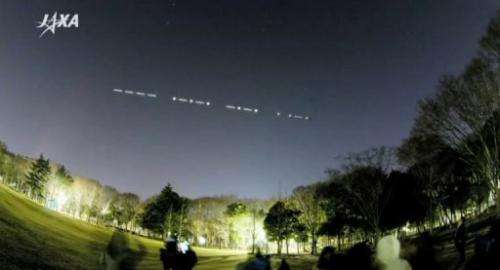Japan mini-satellite to flash code from space

A palm-sized Japanese satellite in orbit around Earth will flash a Morse code message that will be visible around the world from next month, the mission commander said Friday.
Researchers hope the satellite, measuring 10 centimetres (four inches) cubed and launched from the International Space Station on Friday, will become the first orbiter to transmit an LED message across the night sky.
The message was originally intended to be seen just in Japan, but people around the world have asked for the satellite to communicate when it overflies them, said Takushi Tanaka, professor at The Fukuoka Institute of Technology.
"Requests came from far more people than I expected—a man in Silicon Valley wanted to see it while another man wanted us to flash it over Central Park in New York," Tanaka told AFP by telephone.
He said he has also received requests from residents of cities in Italy, Germany, Brazil, Britain and Hungary.
"There is no practical aim to this, but it is a fun experiment that everybody can join," he said.
Observers, ideally with binoculars, will be able to see flashes of light—green in the northern hemisphere, where people will see the "front" of the satellite, and red in the southern hemisphere, where the "back" will be visible.

Morse code uses a series of dots and dashes to represent letters of the alphabet and is commonly understood across the world as a way of transmitting pieces of text.
"A man in Slovakia who has laser beam said he would flash back if he sees the message from space. He wants the satellite to take pictures of his beam and send them to Earth," Tanaka said.
The professor said his team would try their best to accommodate requests but warned being able to see the Morse code message would be largely dependent on the weather.
The message it will send is "Hi this is Niwaka Japan". Niwaka is the satellite's nickname and reflects a play on words in the local dialect of southwestern Japan.
Besides transmitting its LED message, the camera-equipped satellite will also take images of Earth and send them to a base station in an experiment on high-speed data transmissions.
The solar-powered device was released from the International Space Station 390 kilometres (242 miles) above Earth and is now in a regular orbit.
Specific timings and locations will be announced later on the institute's website—www.fit.ac.jp/kenkyu/fitsat1/—in Japanese and English.
(c) 2012 AFP


















